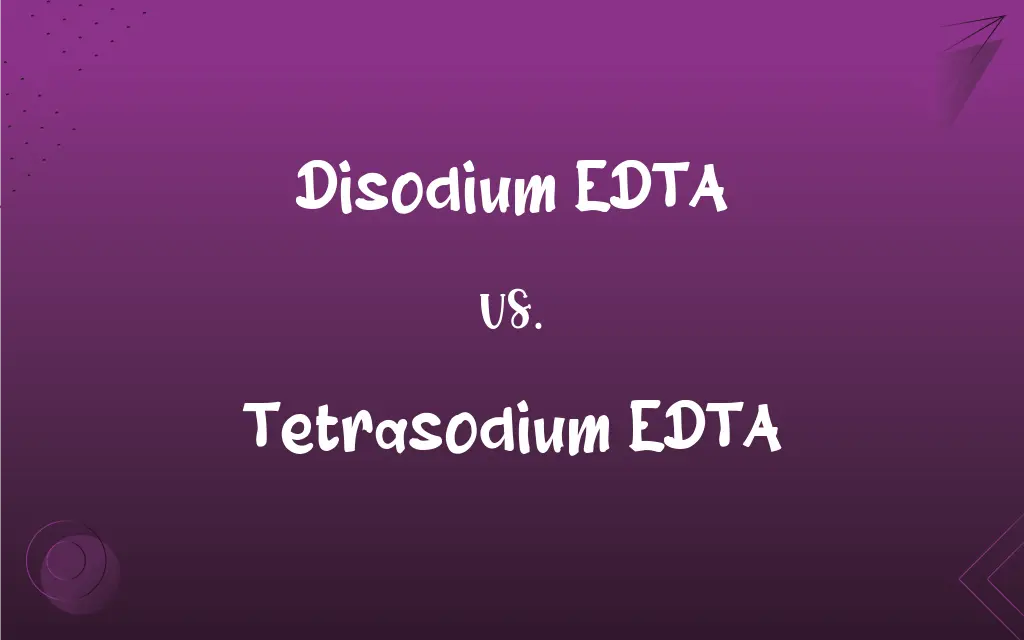Disodium EDTA vs. Tetrasodium EDTA: What's the Difference?
Edited by Aimie Carlson || By Harlon Moss || Updated on October 23, 2023
Disodium EDTA has two sodium ions, while tetrasodium EDTA has four; both are chelating agents.

Key Differences
Disodium EDTA is a salt of ethylenediaminetetraacetic acid, possessing two sodium ions. As a chelating agent, it binds to metal ions, preventing them from participating in undesirable reactions. Its presence in products like shampoos and soaps aids in enhancing stability and preventing deterioration. Tetrasodium EDTA, on the other hand, is a variation of the same compound but contains four sodium ions. This variant also serves as a chelating agent and offers similar benefits, ensuring the longevity and quality of products.
In cosmetic formulations, both disodium EDTA and tetrasodium EDTA play an essential role. Their inclusion ensures that the products remain clear and vibrant, unaffected by metal ions present in water or other ingredients. While disodium EDTA is more common in slightly acidic to neutral products due to its specific pH compatibility, tetrasodium EDTA is suited for alkaline or neutral formulations, given its pH profile.
In the world of medicine, disodium EDTA has been used for chelation therapy, a process of removing heavy metals from the bloodstream. Tetrasodium EDTA, while also possessing chelating capabilities, is not the primary choice for such treatments. Instead, it finds its primary utility in the cosmetic and industrial sectors.
It's worth noting that while both disodium EDTA and tetrasodium EDTA share similar core functions, the choice between them depends on the specific requirements of a formulation, especially considering pH compatibility. Producers and chemists carefully select the appropriate version to ensure the effectiveness and stability of their products.
Comparison Chart
Number of Sodium Ions
Two
Four
ADVERTISEMENT
Function
Chelating agent
Chelating agent
PH Compatibility
Slightly acidic to neutral
Alkaline to neutral
Primary Use
Cosmetics, shampoos, chelation therapy in medicine
Cosmetics, detergents
Stability Function
Prevents deterioration by binding to metal ions in products
Ensures product clarity by binding to metal ions in alkaline bases
Disodium EDTA and Tetrasodium EDTA Definitions
Disodium EDTA
A chemical frequently used in chelation therapy.
The patient received a dose of disodium EDTA to remove heavy metals from his bloodstream.
ADVERTISEMENT
Tetrasodium EDTA
A salt of ethylenediaminetetraacetic acid ideal for alkaline formulations.
The soap, being alkaline, benefited from the addition of tetrasodium EDTA.
Disodium EDTA
A chelating agent with two sodium ions.
Disodium EDTA was added to the shampoo to improve its stability.
Tetrasodium EDTA
An ingredient used predominantly in cosmetics and industrial applications.
The paint remained vibrant longer, thanks to tetrasodium EDTA.
Disodium EDTA
A salt derived from ethylenediaminetetraacetic acid used in cosmetics.
The inclusion of disodium EDTA ensured the lotion remained clear over time.
Tetrasodium EDTA
A variant of EDTA enhancing product stability in alkaline bases.
With tetrasodium EDTA, the cleaning solution resisted metal-induced cloudiness.
Disodium EDTA
A compound effective in binding metal ions in products.
To prevent metal-induced spoilage, disodium EDTA was introduced to the formulation.
Tetrasodium EDTA
A compound preventing product deterioration by binding to metal ions.
The clear gel remained unchanged due to the presence of tetrasodium EDTA.
Disodium EDTA
An ingredient enhancing the longevity and quality of cosmetic products.
Disodium EDTA prevented the discoloration of the cream when exposed to metal ions.
Tetrasodium EDTA
A chelating agent possessing four sodium ions.
Tetrasodium EDTA was a primary ingredient in the detergent, ensuring clarity.
FAQs
Is tetrasodium EDTA suitable for acidic products?
No, tetrasodium EDTA is best suited for alkaline or neutral formulations.
In which products is disodium EDTA commonly found?
Disodium EDTA is prevalent in cosmetics, shampoos, and some medical treatments.
Why are these EDTA compounds added to products?
Both enhance product stability, preventing deterioration from metal ions.
Can either compound cause allergic reactions?
While rare, some individuals may exhibit sensitivity or allergic reactions.
Are these compounds safe for regular use in cosmetics?
Yes, when used in recommended amounts, they're considered safe.
Which EDTA variant is ideal for a neutral pH product?
Both can be used, but the specific choice depends on the product's formulation and requirements.
Which variant of EDTA is more common in shampoos?
Disodium EDTA is more commonly found in shampoos.
Why is pH compatibility important when choosing between the two?
pH compatibility ensures the compound works effectively without altering the product's desired pH.
Do both compounds enhance the longevity of products?
Yes, both prevent product deterioration by binding to metal ions.
How do I identify these compounds on product labels?
Look for "Disodium EDTA" or "Tetrasodium EDTA" in the ingredient list.
Are disodium EDTA and tetrasodium EDTA natural compounds?
No, they are synthetically produced.
Which one is more suited for industrial applications?
Tetrasodium EDTA is often chosen for certain industrial applications due to its pH profile.
How do these compounds prevent product discoloration?
By binding to metal ions, they prevent undesirable reactions leading to discoloration.
Are there environmental concerns related to these EDTAs?
Some concerns exist about their biodegradability and potential accumulation in the environment.
Can I substitute one for the other in a formulation?
Not always. Considerations like pH compatibility and specific formulation requirements play a role.
What's the primary function of disodium EDTA?
Disodium EDTA serves as a chelating agent, binding to metal ions.
How many sodium ions does tetrasodium EDTA have?
Tetrasodium EDTA contains four sodium ions.
Are both compounds used for chelation therapy?
While disodium EDTA is used for chelation therapy, tetrasodium EDTA isn't the primary choice.
Can I find tetrasodium EDTA in my facial cleanser?
Yes, it's possible, especially if the cleanser has a neutral to alkaline pH.
Is one compound more effective than the other?
Both are effective chelating agents; the choice depends on the specific product's needs.
About Author
Written by
Harlon MossHarlon is a seasoned quality moderator and accomplished content writer for Difference Wiki. An alumnus of the prestigious University of California, he earned his degree in Computer Science. Leveraging his academic background, Harlon brings a meticulous and informed perspective to his work, ensuring content accuracy and excellence.
Edited by
Aimie CarlsonAimie Carlson, holding a master's degree in English literature, is a fervent English language enthusiast. She lends her writing talents to Difference Wiki, a prominent website that specializes in comparisons, offering readers insightful analyses that both captivate and inform.































































